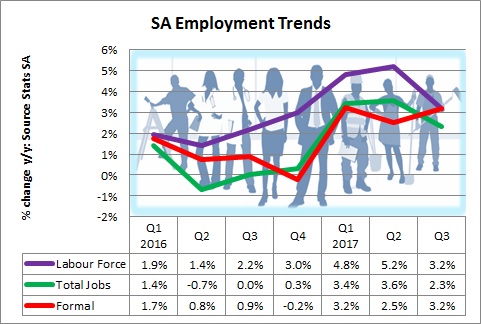
The third quarter 2017 Quarterly Labour Force Survey (QLFS) released by Statistics South Africa (Stats SA) shows that there was a 38.2% or 216,000 year-on-year (y/y) surge in the number of unemployed to 781,000 in Eastern Cape (EC). Although this is cause for alarm, the analysis needs to be nuanced, as better job prospects can result in a rise in the number of unemployed, as people move from the not economically active category either into the employed or looking for work category.
The data showed that because I know a friend who has now got a job that makes it worth my while for me to start looking for a job as well. That is why the number of discouraged workers (i.e. those who had given up looking for a job), declined by 25,000 in the third quarter from a year ago, whereas the number of people aged 15-64 rose by 50,000 or only 1.2% y/y. The move of not economically active in the labour force due to better job prospects meant that the labour force increased by 194,000 or a massive 9.7% y/y.
However, what is relevant for Grahamstown is the non-metro EC data. This showed that the working age population grew by 1.2% y/y, while the labour force surged by 8.0% y/y. The smaller increase for the non-metro area is in part due to the perception that there are more employment opportunities in metro areas and this is borne out by the facts as employment in the non-metro areas declined by 5.2% y/y, while in Nelson Mandela Bay it increased by 5.1% y/y and in Buffalo City it rose by 2.4% y/y. The drop in non-metro areas was largely due to the drought as that affected agricultural employment.
At national level the result was that instead of the labour force growing by the “natural” rate of 1.7% year-on-year (y/y), the increase due to discouraged workers and not economic active people, such as students and housewives, joining the labour force, the increase was 3.2% y/y. That is the dilemma politicians and economic commentators face. The more job prospects improve, which is great, the higher the unemployment rate is, as it attracts the discouraged workers and those who were not previously economically active into the labour force. That is why the unemployment rate rose to 27.7% in the third quarter from 27.1% a year ago even as labour force participation increased from 59.1% in the third quarter 2016 to 59.9% in the third quarter 2017. This is not far below the current American labour force participation rate of 63%.
From an economic analysis point of view, the most important data series is that of formal employment growth. This showed an acceleration to 3.2% y/y in the third quarter from 2.5% y/y in the second quarter and explains why new vehicle sales grew on a y/y basis for the fifth consecutive month in October. A formal job gives you a a payslip that allows you to access credit, which is what you need to buy a new car as very few people are able to buy a new car cash. So despite the bad news of headline unemployment being stuck at 27.7% for the third consecutive quarter, there is good news if you focus on employment growth.


